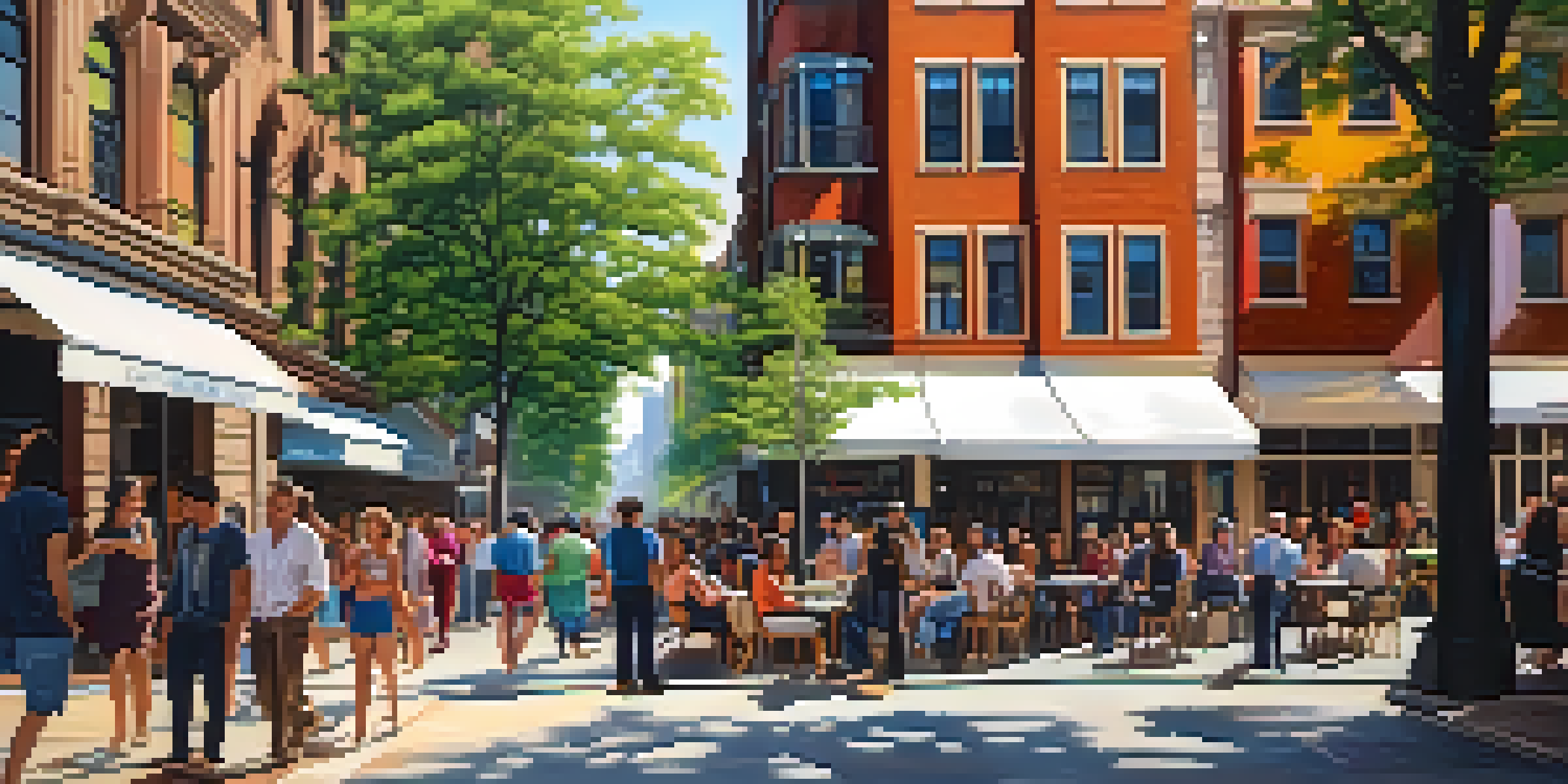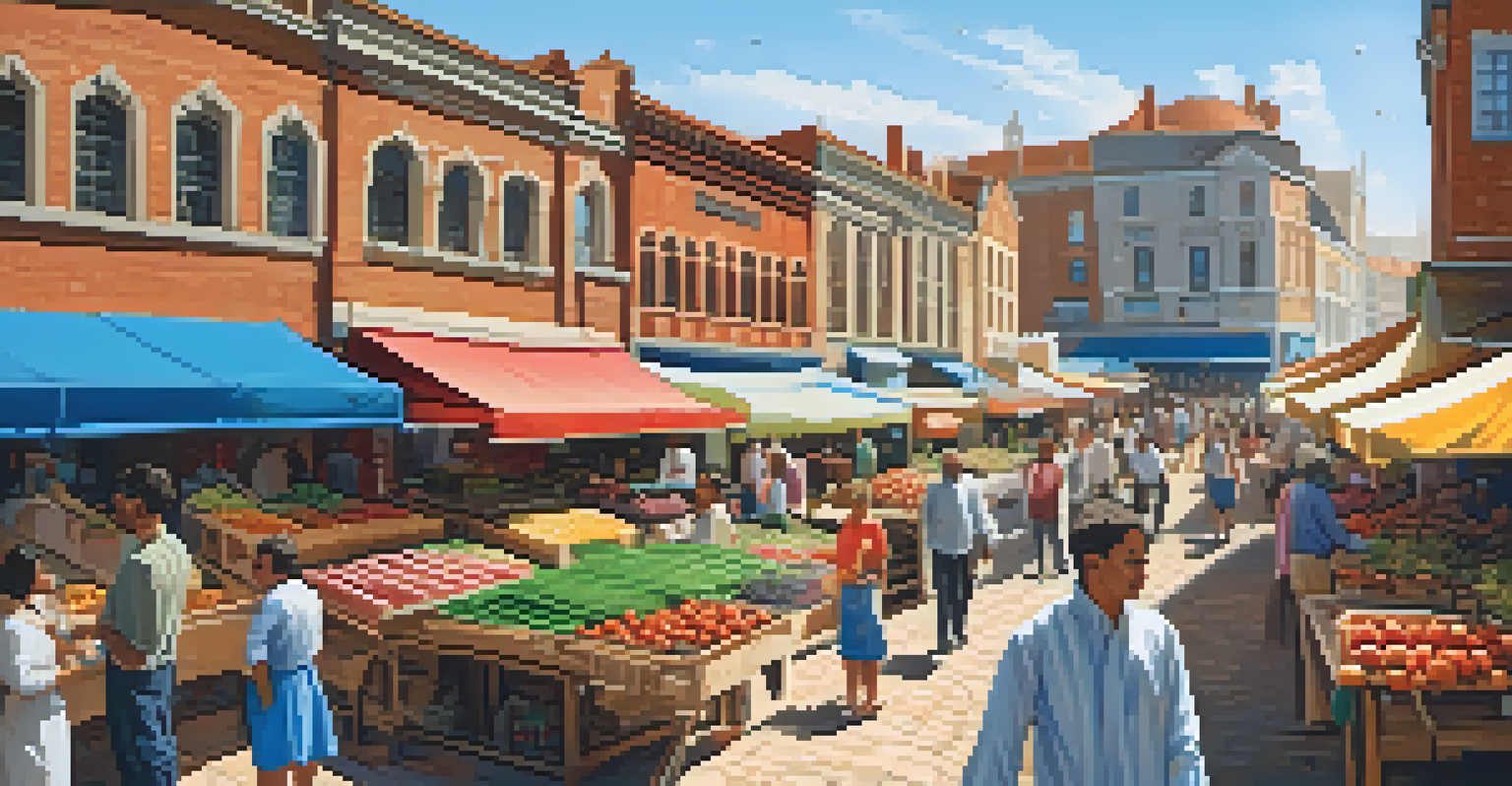Social Dynamics: How Gentrification Reshapes NYC Communities

What is Gentrification and Why Does it Matter?
Gentrification refers to the process where urban neighborhoods undergo transformation, often leading to an influx of higher-income residents. This shift can result in rising property values and changes in the local culture. Understanding gentrification is crucial because it affects the social fabric of communities, reshaping everything from local businesses to public services.
Gentrification is a process of urban transformation that often triggers a clash of cultures, values, and identities.
This phenomenon often sparks heated debates about economic development versus displacement. For longtime residents, it can feel like their neighborhood is being taken over, while newcomers may view it as an opportunity for revitalization. The balance between these perspectives is delicate and often fraught with tension.
Ultimately, gentrification isn't just an economic issue; it's a social one that asks us to consider who belongs in a community and who gets to decide its future. As we delve deeper into its effects on New York City, we'll uncover the complex layers of this urban transformation.
Historical Context: Gentrification in NYC
To understand gentrification in New York City, we must first look at its history. The late 20th century saw significant urban decline, with many neighborhoods suffering from disinvestment and crime. However, as the city worked to revitalize itself, areas like the Lower East Side and Williamsburg became attractive to developers and young professionals looking for affordable options.

This shift was not sudden; it unfolded over decades, influenced by policies like rent stabilization and economic booms. As artists and creative types moved into these neighborhoods, they often sparked interest from more affluent residents, leading to the changes we see today. The cycle of investment and displacement has been a constant theme in NYC's story.
Gentrification reshapes communities
The process of gentrification transforms urban neighborhoods, leading to rising property values and changes in local culture.
By examining the historical context of gentrification, we can better understand its current implications. This backdrop highlights the ongoing struggle between preserving the unique character of neighborhoods and embracing economic growth.
Economic Impacts of Gentrification on Local Communities
One of the most noticeable effects of gentrification is the economic transformation of neighborhoods. As new businesses open and property values increase, local economies can thrive, creating job opportunities and enhancing services. However, this economic boost often comes at a cost for long-term residents who may find it increasingly difficult to afford their homes.
The challenge is to embrace the change while preserving the essence of what makes a neighborhood unique.
For example, small businesses that once catered to the local population might close due to rising rents, replaced by upscale shops that cater to newcomers. This shift can lead to a loss of cultural identity and the erosion of community ties. The local flavor that once defined these neighborhoods can be overshadowed by commercial interests.
Economically, gentrification presents a double-edged sword: while it can invigorate a community, it can also lead to significant displacement. Striking a balance that benefits all residents remains a significant challenge for policymakers and community leaders.
Social Dynamics: Community Response to Gentrification
As neighborhoods gentrify, the social dynamics within these communities change dramatically. Long-term residents may feel a sense of loss as they witness their familiar surroundings evolve, prompting mixed feelings about their place in the community. This emotional response often leads to grassroots movements aimed at preserving the neighborhood's character.
Community organizations and local activists work tirelessly to advocate for affordable housing and tenant rights, striving to ensure that all residents can remain in their homes. These efforts can include everything from organizing protests to engaging in policy discussions with local government. Their work highlights the importance of community voice in navigating the complexities of urban change.
Economic impacts vary for residents
While gentrification can boost local economies, it often displaces long-term residents, complicating the balance between growth and affordability.
Ultimately, the response to gentrification reflects a broader struggle for equity and inclusion. By fostering dialogue between old and new residents, communities can find common ground and work together to create a future that honors both heritage and progress.
Cultural Shifts: The Impact of Gentrification on Identity
Gentrification brings not only economic changes but also significant cultural shifts. As new residents move in, they often bring different values, lifestyles, and expectations, which can clash with the existing community's culture. This cultural infusion can lead to a vibrant mix of ideas, but it can also result in tensions and misunderstandings.
For instance, local art scenes may evolve as new artists and galleries emerge, transforming the creative landscape of a neighborhood. However, longstanding traditions and cultural practices can sometimes be overshadowed or lost in the process. This raises important questions about identity and belonging in a changing urban environment.
Navigating these cultural dynamics requires sensitivity and openness from all community members. By embracing diversity and fostering mutual respect, neighborhoods can work toward a shared identity that honors both new and old residents.
Policy Responses: Addressing Gentrification Challenges
Policymakers play a crucial role in managing the effects of gentrification on communities. Various strategies can be employed to mitigate displacement and promote equitable development, such as implementing rent control measures and creating affordable housing initiatives. These policies aim to balance the interests of developers and residents, ensuring that neighborhoods remain accessible to all.
Additionally, investment in infrastructure and community services can help support both new and existing residents. For example, improving public transportation and enhancing public spaces can benefit the entire community, fostering a sense of shared ownership. Policymakers must prioritize inclusive growth to avoid exacerbating existing inequalities.
Community response fosters equity
Grassroots movements and community organizations play a vital role in advocating for affordable housing and preserving neighborhood character amidst gentrification.
Effective policy responses require collaboration with community members to ensure that initiatives reflect their needs and aspirations. By engaging residents in the decision-making process, cities can create more resilient and harmonious neighborhoods.
The Future of NYC Communities in a Gentrified Landscape
Looking ahead, the future of New York City's communities will largely depend on how we address the challenges posed by gentrification. As neighborhoods continue to evolve, finding ways to integrate new residents while preserving community heritage will be critical. This balancing act requires thoughtful planning and ongoing dialogue among all stakeholders.
Moreover, promoting sustainable development practices can help ensure that neighborhoods thrive without displacing long-standing residents. Initiatives that prioritize green spaces, local businesses, and community engagement will foster a sense of belonging that benefits everyone. The goal should be to create neighborhoods that are not only economically prosperous but also socially cohesive.

In conclusion, the future of NYC communities in a gentrified landscape hinges on our collective commitment to inclusivity and equity. By embracing the diverse voices within our neighborhoods, we can build a vibrant city that honors its past while looking forward to a shared future.